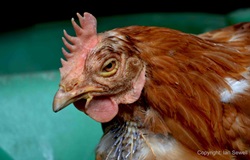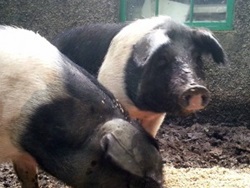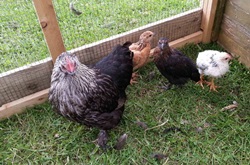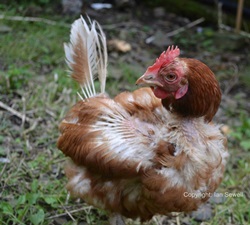![]()
After all this time you’d have thought we’d have learnt.
“We’ll do some research before we get any more animals”.
“Yep, it’s much easier when we know what we’re letting ourselves in for.”

That should have been enough don’t you think? In future, we’d find out what we were about to embark upon before we increase our livestock and in particular double our chicken flock with rescue hens. But that wouldn’t be any fun….

When it came to our first attempts at pig rearing last year, we absolutely did our homework. We trotted off to Old Farm and spent a day learning about fencing, feeding and generally caring for pigs before our two saddlebacks arrived. Even then we continued to learn throughout the months that followed, quickly realising that nothing can fully prepare you for the first time you have to take animals off to slaughter.

With the chickens we were self-taught. We assumed hens would be straightforward, lots of folk we know have them and so far our hens have been purely for their egg laying capabilities. We’d planned to get some brooders this year for the freezer but with a fox lair close by, knew we’d have to build runs etc to contain them at night so that, at least, is still on the ‘to do’ list.

The internet has been a great resource for us over recent years and poultry books helpful but nothing can really prepare you for rearing livestock. I did chat with the woman on the end of the phone line a wee bit when I rang to enquire about the 5,000 hens she was rescuing and hoping to re-home:
“We have a small flock of hens, how well will ex-batteries integrate with them?”
“Fine, no bother at all.”
“We’ll take four then”
“Would you not have room for a few more?”
“Ok, we’ll take eight”
Some hours later….
“You’ve done whaaaat?”
This all happened several months ago. Back then we had an attractive little flock, led by a very good-looking White Sussex cockerel. Sadly, the local fox began to pick the chickens and ducks off, one by one, boldly and in midday light, until he finally reached the prize he was looking for – Bob, our magnificent rooster. We hope he choked on one of the glorious tail feathers that weren’t left strewn on the lawn in Bob’s last fight for survival.
We haven’t seen the fox since.
After the horrors of helplessly watching our flock diminish, we were left with just three little hens, two of whom were broody and sitting on fertilised eggs.The eggs hatched, four healthy little chicks were born and our flock increased back to a manageable size of seven. Happy days. Then the phone call came…

“The hens are being released, I’ll met you Thursday at the handball club”
Eeeek! Seven to fourteen hens overnight and if they all lay eggs, that’s a lot of omelettes!
I should mention at this point that although I’ve referred to the hens as ex-batteries, due to a European ruling in 2012, commercial hens these days are no longer confined to the wire cages of old, they are now kept in ‘enriched’ cages where they can at least flap their wings. In the case of our new arrivals, they’ve come from a free range environment. That said, free range commercial farming and free range hobby farming are two different things. Commercially the hens are replaced every year and from what I can gather, the year old ones simply destroyed unless rescued. That leads to my point about the ‘hoods’.

After the hens had been here a few days I googled ‘rehoming ex batteries’. Apparently, far from the featherless, poor little things I’d conjured up in my imagination, rescue hens are very street wise. Even free range, they’ve been reared in cramped conditions, sharing space with thousands of other birds and have had to adapt, learning to fight for their small bit of territory.
During the week they’ve been here, we’ve noticed they’re very brave and wander around bits of our property the other hens never ventured to. They’re also very friendly and don’t mind being handled. They haven’t figured out what the scraps thrown out the window are yet and they sleep almost on top of one another, even though they now have space to stretch and move around. Some of the hens were quite featherless, perhaps from being picked on but they’re certainly holding their own with our existing flock. Already we can tell our feed bill will be rising considerably and although ex-batteries aren’t supposed to lay many eggs, that message doesn’t seem to have reached our new ladies and we now have more eggs produced than we can manage.

Overall, the hens seem to be integrating nicely and if one of the recent chicks does turn out to be the cockerel we think he might be, his father’s very good looking son, he’ll be a very happy lad indeed surrounded by so many ladies. They may however, take a bit of persuading to be receptive to his advances as I somehow think the new girls wont be taking any nonsense, no matter how long and glorious his tail feathers might be.
And as for our homework? Well our bee suit arrived this week so we best start looking into those beekeeping courses as the honeybees I wrote about in June have not only stayed, but have bred like mad.
If you’re thinking of keeping hens, the Consumer Association have a handy guide and if you’re thinking of re-housing ex-battery or rescue hens, poultrykeeper.com have a list of common health problems you might meet.
Have you thought about rescuing hens or already done so? How did you find the experience?

Dee Sewell – a horticulturalist and certified trainer who started Greenside Up in 2009 and teaches people how to grow vegetables. Dee specialises in working with community gardens but also offers workshops, allotment visits, consultations, horticultural therapy, afterschools clubs as well as local talks – she tailors her services to meet clients needs. In 2012 Dee launched a Seed Gift Collection containing varieties of vegetable and insect friendly flowers with the aim of getting more people growing. Dee’s blog was a finalist in the 2012 Ireland Blog Awards in the Eco/Green and Lifestyle Categories.
Source: GreensideUp – Uh-Oh, The ‘Hoods’ Have Arrived – Dee Sewell




